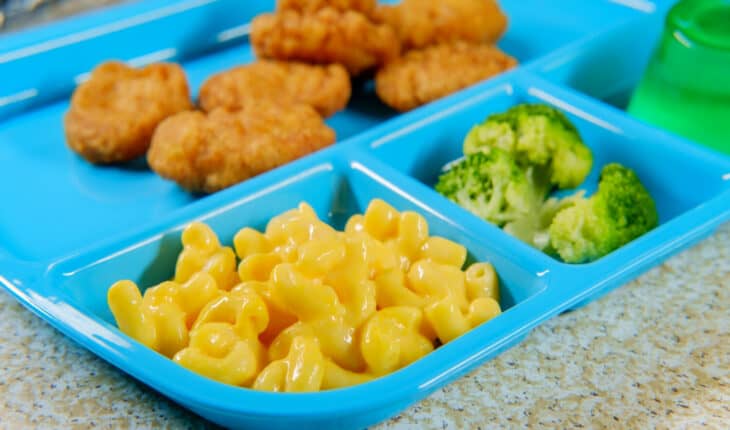Ultra-processed foods make up almost two-thirds of Britain’s school meals: School meals in the UK contain lots of highly processed foods, promoting poor health among children and increasing their risk of obesity.
British primary and secondary schoolchildren are getting the majority of their lunchtime calories from ‘ultra-processed’ foods, according to a study led by researchers at Imperial College London and published in the journal Nutrients.
The analysis, which looked at the content of school lunches of more than 3,000 children between 2008-2017, finds that 64% of the calories in meals provided by the school come from ultra-processed foods, contributing to the consumption of high levels of processed foods and increasing the risk of childhood obesity. Ultra-processed bread, snacks, puddings and sugary drinks were among the biggest contributors, and on the whole packed lunches contained more calories from highly processed foods, compared to school meals.
According to the researchers, publicly funded school meals (i.e. free school meals and those that children buy in school) are a vital mechanism to deliver healthy food to children, especially those from families with low incomes. They explain the findings highlight a key opportunity for policy makers and educators to ‘level the playing field’ by improving the nutritional quality of school lunches. They argue that urgent policy changes are needed to cap the amount processed foods school lunches contain and to increase access to free school meals, which could help to boost the diets and health of Britain’s children.
Dr Jennie Parnham, from the School of Public Health at Imperial College London and first author on the paper, said: “This is the first study to look at the extent of ultra-processed food content in school lunches for children of all ages. We need to view these findings as a call to action to invest in policies that can promote healthy eating. Owing to the current cost of living crisis, school meals should be a way for all children to access a low-cost nutritious meal. Yet, our research suggests this is not currently the case.”
She continued: “Ultra-processed foods are often cheap, readily available, and heavily marketed – often as healthy options. But these foods are also generally higher in salt, fat, sugar, and other additives, and linked with a range of poor health outcomes, so it’s important that people are aware of the health risks of children consuming them in high levels at school.
“As food prices continue to rise in the UK and globally, accessing affordable, healthy food will become more challenging for many more people. School meals should offer children from all backgrounds access to a healthy and minimally processed meal, yet they are currently failing to meet their potential.”
Ultra-processed foods (UPFs) are items which are heavily processed during their making: such as frozen pizzas, fizzy or milk-based drinks, mass-produced packaged bread and many ready meals.[1] Previous research has linked regular consumption of them with obesity and increased long-term risk of health conditions like Type 2 diabetes, cardiovascular disease and cancer.
Previous research by the team reported the scale of UPFs being consumed by children in the UK, which is the highest in Europe. The work also highlighted that eating patterns established in childhood extend into adulthood, potentially setting children on a lifelong trajectory for obesity and a range of negative physical and mental health outcomes.
In the latest study, the team looked at the diets of more than 3,300 children in primary and secondary school, collected through the National Diet and Nutrition survey [2]. The aim was to examine the proportion of UPFs in packed lunches (food brought from home) and school meals (which includes lunches provided by the school (free school meals) or bought by students at the school canteen).
The analysis included data from 1,895 primary school children (aged 4-11) and 1,408 secondary school children (aged 11-18), looking at food groups making up the total calorie count, as well as the proportion of total food intake of the meal (in grams).
Overall, around 75% of calories across all types of school lunches came from UPFs – with 82% of calories from UPFs in packed lunches, compared with 64% in school meals – across all ages.
However, within school meals the study found that secondary schoolchildren had higher levels of UPFs (70% of calories) compared to primary schoolchildren (61% of calories). Secondary school meals contained a higher proportion of calories from fast food items, puddings and desserts.
In general, children from lower-income backgrounds were more likely to have higher levels of UPF on their plates (77% of calories) than children from higher-income backgrounds (71% of calories).
In primary school, almost half of the calories in packed lunches came from ultra-processed bread and snacks, compared to just 13% of calories of school meals. Packed lunches also tended to have fewer calories from minimally processed fruit and veg, meat and dairy, and starch (such as pasta or potatoes), compared to school meals.
One of the largest UPF contributors, as a proportion of grams of food intake, came from ultra-processed drinks – such as fizzy drinks, fruit juice, or yogurt drinks. According to the team, one of the easiest and most cost-effective opportunities to improve the nutritional value of school lunches would be to swap these high calorie, ultra-processed drinks for water.
While the work is the first to bring together both primary and secondary school settings, the researchers highlight the limitation that secondary schoolchildren self-reported their dietary data while primary schoolchildren did not, but this mostly likely means that the scale of UPFs being consumed by secondary schoolchildren is under-estimated.
Dr Eszter Vamos, from Imperial’s School of Public Health, added: “With the rising cost of living, many families are struggling to access healthy foods, and school meals might be the only opportunity for many children to have a healthy regular main meal. School meals are critically important in making sure that every child has access to an affordable nutritious meal.
“Children in England consume very high levels of ultra-processed foods, and it is worrying that meals consumed at school contribute to this. Our findings call for urgent policy changes to improve the accessibility and quality of school meals as this could shape children’s overall diets considerably with important consequences for their current and future health.”
This study is funded by the National Institute for Health and Care Research (NIHR), through the NIHR School for Public Health Research.
‘The ultra-processed food content of school meals and packed lunches in the United Kingdom’ by Jennie Parnham is published in Nutrients.
[1] The term ‘ultra-processed food’ comes from the NOVA classification, endorsed by the World Health Organization and the Food and Agriculture Organization of the United Nations, and is the most widely researched and validated food processing classification.
NOVA categorises all foods and beverages into four groups based on their degree of industrial processing.
Group 4: Ultra-processed foods, are mass-produced products using a series of industrial processes that include fractioning of a few whole foods into oils, fats, sugar, protein and other substances before recombining them back together.
They typically have high levels of sugar, salt and saturated fat, and are often loaded with industrial substances that are not found in a household kitchen, such as additives to enhance colour and flavour, and those enable modification of shape and texture.
They are designed to be cheap, convenient, durable, extremely tasty and attractively packaged. They are heavily marketed and created to displace all other foods and dishes.
Examples include soft drinks, mass-produced packaged bread, flavoured yoghurts, most breakfast cereals, confectionery, packaged sweet and savoury snacks, chicken and fish ‘nuggets’, and many ready meals.
Ultra-processed foods can be identified from the following characteristics: A long list of ingredients; Ingredients that you don’t recognise or wouldn’t use at home, such as additives; High fat, sugar and salt content; Long shelf life.
Details of the NOVA classification of food types can be found online: https://www.fao.org/3/ca5644en/ca5644en.pdf
Full details can also be found in the group’s previous work:
https://www.imperial.ac.uk/news/223573/urgent-action-needed-reduce-harm-ultra-processed/
[2] The study used nationally representative data from the UK’s National Diet and Nutrition Survey (2008-2017). https://www.gov.uk/government/collections/national-diet-and-nutrition-survey
- The da Vinci 5 Robot Is Set To Transform Bariatric Care: - 31st March 2025
- Beyond money: the hidden drivers fuelling child food insecurity - 31st March 2025
- Tobacco and Vapes Bill - 31st March 2025






